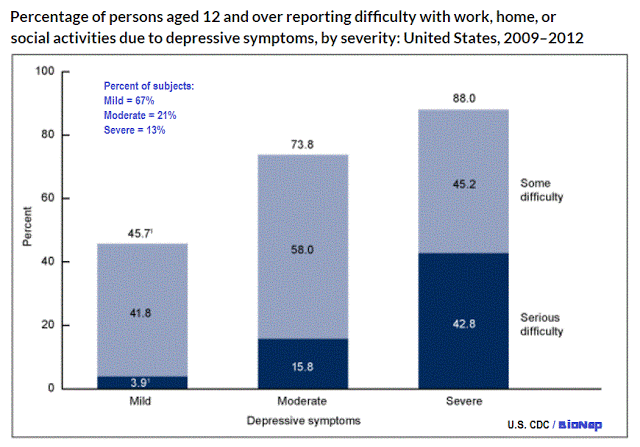TM editors’ note: This article discusses a penny stock and/or microcap. Such stocks are easily manipulated; do your own careful due diligence.
April 7th is World Health Day. It’s celebrated every year on the 7th to mark the anniversary of the founding of the World Health Organization (WHO). WHO is a specialized agency of the United Nations with a primary focus on concerns of international public health. In its 69 year existence, WHO has played a major role in combating diseases on a global basis, including eradicating smallpox and fighting pandemics such as HIV/AIDS, Ebola, malaria, and tuberculosis. However, the theme for 2017 is a bit different from the past focus on communicable diseases. For 2017, WHO is targeting depression.
The involvement of WHO is likely to bring significant media attention and public awareness to depression. This marries well with recently media coverage and scientific publications around ketamine and NMDA receptor targeting as a novel strategy to treat depression. For the purpose of this article, I look at three companies targeting depression through NMDA pharmacology and which of these names might offer the best returns over the next year or two.
An Enormous Market
This year, WHO will undertake a media campaign designed to create education and awareness for depression. Depression affects people of all ages, from all walks of life, in all countries. It causes mental anguish and impacts on people’s ability to carry out even the simplest everyday tasks, with
sometimes devastating consequences for relationships with family and friends and the ability to earn a living. WHOs overall goal of this campaign is to get people with depression to seek and get help for their disease. The campaign slogan is: Depression – Let’s Talk.

WHO estimates that depression affects 300 million people around the world and is the leading cause of disability worldwide (1). Common symptoms are depressed (or irritable) mood, diminished interest or loss of pleasure in almost all activities, sleep disturbance, weight change, appetite disturbance, decreased concentration or indecisiveness, suicidal ideation or thoughts of death, agitation or quietness, fatigue or loss of energy, and feelings of worthlessness or inappropriate guilt. According to WHO, depression was ranked as the third leading cause of the global burden of disease in 2004 and will move into the first place by 2030 (2).
The statistics are staggering. According to the CDC’s National Center for Health Statistics, 7.6% of the U.S. population over the age of 12 years suffer from depression (3). Almost 10% of adults aged 40-59 report depression; women outnumber men nearly 2:1. Based on 2015 Census data, this equates to approximately 21 million individuals. Data from the U.S. National Institute of Mental Health (NIMH) pegs the number slightly lower at 6.7% of all U.S. adults, equating to 16 million individuals (4). Whatever the exact number, it’s clearly a large market. The Anxiety and Depression Association of America (ADAA) estimates the direct costs of the disease at $42 billion per year (5). The total economic burden, which includes workplace costs and suicide-prevention costs, totaled over $210 billion in 2010 (6).
According to the CDC, two-thirds of individuals with depression report mild symptoms, roughly half of who note some difficulty at work, home, and in social activities. Rates of any difficulty with activities related to depressive symptoms increased as the severity of those symptoms increased, from 74% among persons with moderate depressive symptoms (21% of the cases) to 88% among those with severe depressive symptoms (13% of the cases).

NIMH data shows less than 20% of all Americans with mild to moderate depressive symptoms reported having seen a mental health professional in the past year. Of those with severe symptoms, only 35% reported having contact with a mental health professional in the past year (7). A 2004 report by WHO found several reasons why those with depression do not seek help, including fear and shame (stigma), lack of awareness (anosognosia) to the problem, distrust of medical professionals, and a feeling of hopelessness or unavailability (8). Unfortunately, of the 35% that do seek medical help for their depression, only about two-thirds see any benefit from pharmacotherapy and it can take as many as four different regimens and six months before those benefits are noticeable.
In 2006, results of a seven-year long clinical trial conducted by researchers at the NIMH were published in the American Journal of Psychiatry. The Sequenced Treatment Alternatives to Relieve Depression (STAR*D) trial enrolled nearly 4,000 patients with major depressive disorder (MDD) (9). Subjects were given anti-depressant medication in a linear stepwise fashion. Those subjects who demonstrated an acceptable benefit, preferably symptom remission, from any particular step could enter a 12-month naturalistic follow-up phase. Those not achieving remission with or unable to tolerate a treatment step were encouraged to move to the next anti-depressant medication.
The remission rates were 36.8%, 30.6%, 13.7%, and 13.0% for the first, second, third, and fourth acute anti-depressant medications, respectively. The overall cumulative remission rate was 67% (10). The numbers in the U.S. work out to a target of around 3-4 million patients each year who seek medical help for MDD but are classified as treatment-resistant (i.e. fail multiple lines of anti-depressant medications).









Leave A Comment